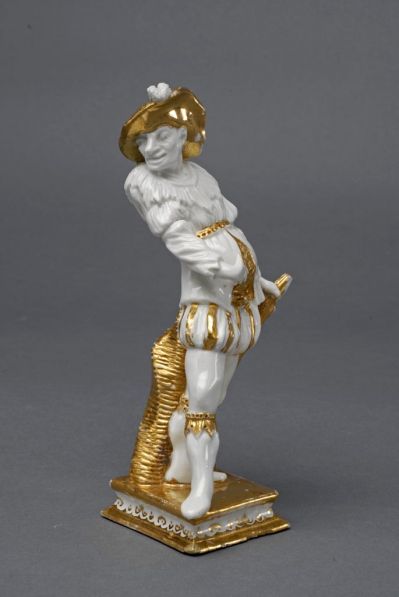
Statuette - Pulcinella from commedia dell'arte
| Accession Nr.: | 5846 |
|---|---|
| Place of production: | Meissen |
In the 16th and 17th centuries, a favourite public entertainment at Italian fairs was the music-and-dance form Commedia dell’ Arte. Travelling companies performed folk tales featuring pairs of opposites – master and slave, rich and poor, young and old, beautiful and ugly, loyal and deceitful, etc. – with caricature and improvisation. The players stood on a wooden stage, often in front of canvas scenery of a town or landscape. The members of the company always played the same figures, in the same costume. The audience could thus easily identify the characters, whose mere appearance set off laughter. The performance was full of ribald jokes and puns based on differences in dialect. For a long time, Commedia dell’ Arte competed with the plays of Moliere and later Carlo Goldoni. Prominent among the characters are young, always-hungry, lazy, sleepy, but crafty servants the Padrones, their masters, who combined all the worst characteristics of rich old people: meanness, ugliness, avarice the scholarly Dottores and the self-important, skirtchasing, boastful Capitanos. Pulcinella is the clever and stubborn servant, who always comes out the loser. This little Bottger-porcelain figure is one of the finest pieces in the porcelain collection, particularly remarkable for the refinement of its modelling. A close look at the tiny details of early Meissen porcelain reveals the glaze not to be perfectly aligned with the base porcelain. The fusible glaze tended to run into the drapery folds and tiny depressions of the sculpture, and so does not cover the figure evenly.
Literature
- Szerk.: Horváth Hilda, Szilágyi András: Remekművek az Iparművészeti Múzeum gyűjteményéből. (Kézirat). Iparművészeti Múzeum, Budapest, 2010. - Nr. 73. (Balla Gabriella)
- Szerk.: Pataki Judit: Az idő sodrában. Az Iparművészeti Múzeum gyűjteményeinek története. Iparművészeti Múzeum, Budapest, 2006. - Nr. 115. (Balla Gabriella)
- Szerk.: Szilágyi András, Péter Márta: Barokk és rokokó. Az európai iparművészet stíluskorszakai. Iparművészeti Múzeum, Budapest, 1990. - Nr. 6.157. (Katona Imre)
- Nékám Lajosné: Meisseni porcelán a Budapesti Iparművészeti Múzeum gyűjteményében. Corvina Kiadó, Budapest, 1980. - Nr. 5.
- Szerk.: Miklós Pál: Az Iparművészeti Múzeum gyűjteményei. Magyar Helikon, Budapest, 1979. - p. 193.
- Szerk.: Voit Pál, Csernyánszky Mária: Az Iparművészeti Múzeum mesterművei. 1896-1946. Iparművészeti Múzeum, Budapest, 1946. - p. 13.
- Layer Károly: Országos Magyar Iparművészeti Múzeum. Vezető a múzeum gyűjteményeiben. Porcellánplasztika. Athenaeum Kiadó, Budapest, 1933. - 6.
- Sammlung des Königl. ungar. Hofrats Gustav von Gerhardt, Budapest. Versteigerung. I. Kunstgewerbe. Rudolph Lepke's Kunst-Auctions-Haus, Berlin, 1911. - Nr. 90.

